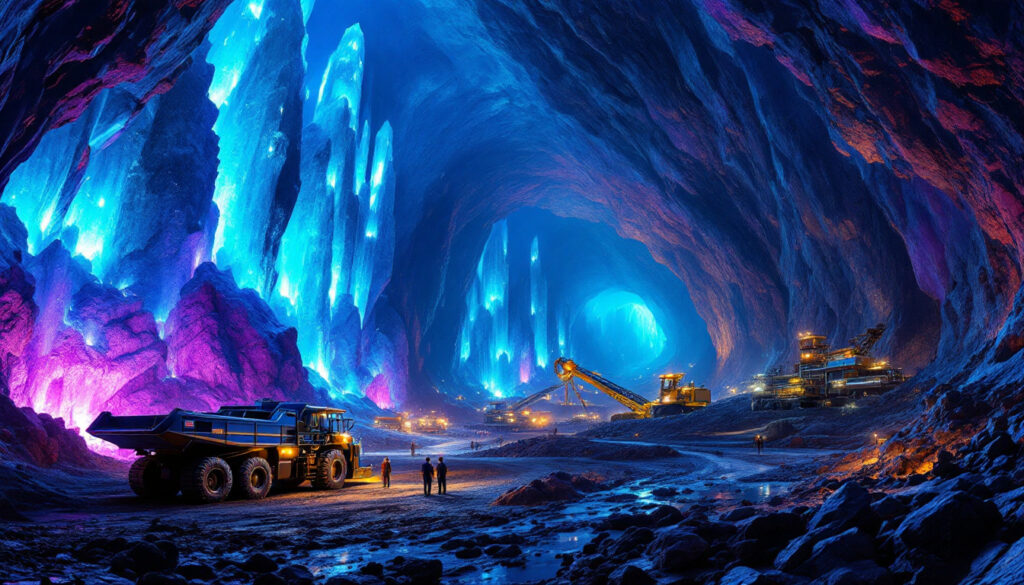US-Ukraine Minerals Agreement: Challenges and Opportunities for Critical Resource Development
The recent US-Ukraine minerals agreement, signed in Washington, establishes a partnership to develop 55 critical minerals alongside oil, natural gas, and hydrocarbons. This deal aims to reduce reliance on Chinese-dominated supply chains while supporting Ukraine's post-war reconstruction. Key elements include revenue-sharing via royalties, license fees, and production-sharing agreements, managed through a limited partnership between the US International Development Finance Corporation and Ukraine's State Organization Agency on Support for Public-Private Partnerships. The agreement focuses on 22 of the 34 minerals classified as critical by the European Union, including lithium, rare earth elements (REEs), and nickel.
Industry experts project a 10-20 year timeline before significant revenue materializes due to war-related infrastructure challenges and insufficient geological data on Ukrainian deposits. Despite these challenges, the minerals deal between US and Ukraine represents a strategic repositioning in the global rare earth reserves market.
Key Elements of the Agreement
The partnership created by the minerals deal between US and Ukraine encompasses a comprehensive framework for developing 55 critical minerals plus traditional energy resources. The agreement establishes a revenue structure based on royalties, license fees, and production-sharing agreements that will fund future development.
This limited partnership between the US International Development Finance Corporation and Ukraine's State Organization Agency on Support for Public-Private Partnership creates a foundation for long-term resource development. The focus on 22 of the EU's 34 designated critical minerals highlights the strategic importance of resources like rare earths, lithium, and nickel in global supply chains.
Strategic Importance for Both Nations
For Ukraine, the minerals deal with the US carries significant political weight, securing continued American support amid the ongoing conflict. The agreement offers a pathway to economic reconstruction through resource development after hostilities end.
The United States gains potential access to rare earth elements and other critical minerals currently dominated by Chinese suppliers. This framework for reducing dependence on China's export restrictions aligns with broader Western efforts to diversify critical mineral sourcing for defense and clean energy technologies.
Why Are Long Timelines Expected for Revenue Generation?
Mining Development Realities
Development timelines for mining projects typically stretch 10-20 years even in stable, established mining jurisdictions like Canada and Australia. In Ukraine's case, Benchmark Minerals Intelligence indicates many deposits lack sufficient geological data to confirm economic viability.
Adam Webb of Benchmark Minerals Intelligence notes: "It's going to be difficult for people to justify investing money there when there are options to invest in critical minerals in countries that are not at war."
The war-damaged infrastructure compounds these development challenges, with significant reconstruction needed for power and transportation networks before large-scale mining operations become feasible. Pre-war licensing moved at a glacial pace, with only about 25 resource licenses issued during the 2012-2020 period.
Investment Challenges in Conflict Zones
Investors remain hesitant to commit capital to Ukraine while security concerns persist. The minerals deal between US and Ukraine notably contains no explicit security guarantees in the agreement text.
"The transition from discovered resources to economically viable reserves requires significant time and investment," explains Willis Thomas, a CRU consultant, highlighting constraints that existed even before the war and are now exacerbated by the conflict.
Mining companies typically require stable, long-term operating conditions before committing hundreds of millions in capital expenditure, particularly for critical minerals projects with complex processing requirements.
How Do Geopolitical Factors Impact the Agreement?
Territorial Control Issues
Seven of 24 potential mining projects identified by Benchmark Minerals Intelligence are located in Russian-occupied territories, complicating development prospects. These projects include deposits of lithium, graphite, rare earths, nickel, and manganese essential to the minerals deal between US and Ukraine.
The Polokhivske lithium deposit, considered one of Europe's largest, sits in a contested region where development remains contingent on future security guarantees. American officials have suggested that US interests in these resources might serve as a deterrent to aggressors, though this remains speculative.
Mining economists note that mineral resources in conflict zones typically command a 30-50% discount in valuation compared to similar deposits in stable regions, reflecting the additional risk premium investors demand.
US-China Strategic Competition
The minerals deal between US and Ukraine emerges amid escalating US-China trade tensions and growing concerns about critical mineral supply chains. The United States currently lacks significant domestic rare earth element production, while China dominates global supply chains with approximately 85% market control of processing capacity.
The Trump administration heavily promoted this agreement, particularly emphasizing potential access to rare earth elements used in defense applications and clean energy technologies. This positions the deal within a broader context of addressing critical mineral shortages that will define 21st-century industrial development.
European allies have closely monitored the agreement as part of their own critical minerals strategies, seeking to reduce dependency on Chinese suppliers for materials essential to the energy transition.
What Are Ukraine's Critical Mineral Resources?
Resource Potential and Distribution
Ukraine possesses deposits of 22 of the 34 minerals designated critical by the European Union, representing significant untapped potential. Current mining royalties and resource fees generate approximately $1 billion annually for Ukraine's government from existing operations.
Under the terms of the minerals deal between US and Ukraine, the new partnership fund will only receive revenue from licenses and agreements established after the deal's signing. The 3,482 resource licenses already in place will not contribute to the partnership revenue, limiting short-term financial benefits.
Ukrainian geologists estimate that less than 20% of the country's mineral resources have been thoroughly mapped using modern techniques, suggesting significant exploration upside potential once security conditions improve.
Key Minerals of Strategic Interest
Rare earth elements found in Ukraine are critical for technology applications ranging from cellphones to advanced defense systems. These elements, particularly neodymium and dysprosium, are essential components in permanent magnets used in electric vehicles and wind turbines.
Ukraine's lithium deposits, particularly the Polokhivske site, are essential for battery production and energy transition technologies. Preliminary studies indicate the deposit could supply enough lithium for approximately 2 million electric vehicle batteries.
Graphite resources important for battery anodes and other applications have been identified in multiple regions, while manganese, nickel, and other battery metals present significant opportunities for development under the minerals deal between US and Ukraine.
What Financial Structures Will Support Development?
Revenue Generation Mechanisms
The minerals deal between US and Ukraine establishes a joint fund to collect proceeds from new resource development. Revenue sources include royalties, license fees, and production-sharing agreements, though the agreement text does not specify exact financial terms or targets.
The structure suggests potential direct government investment similar to state mining companies like Chile's Codelco, which maintains government equity stakes alongside private sector participation. This hybrid model could help attract investment while maintaining national interests in strategic resources.
Mining finance experts note that royalty rates for critical minerals typically range from 3-8% of production value, substantially higher than rates for bulk commodities due to their strategic importance and higher market values.
Investment Requirements and Timelines
Significant capital expenditure will be needed to transition from resource discovery to economically viable reserves. Industry analysts estimate that a mid-sized rare earths or lithium mine requires $300-500 million in development capital before production can begin.
The ongoing war has constrained both time and investment capacity for resource development. The limited partnership structure of the minerals deal between US and Ukraine suggests a potential government-backed mining company approach that could reduce perceived investment risk.
CRU consultant Willis Thomas observes that both pre-war bureaucratic hurdles and current security concerns create substantial barriers to accelerated development. Even with security improvements, permitting, environmental reviews, and community consultations typically add 3-5 years to development timelines.
How Might This Agreement Evolve in the Future?
Potential Development Pathways
Security situation improvements could significantly accelerate the investment timeline for projects under the minerals deal between US and Ukraine. American involvement may increase diplomatic pressure for conflict resolution to enable resource development in contested regions.
Benchmark's Adam Webb notes: "The deal ties the US more closely into Ukraine in that now they've got a bit more of a vested interest in this war coming to an end." This alignment of economic and strategic interests could potentially influence conflict resolution efforts.
Western mining companies will likely require additional security guarantees before committing significant capital to Ukrainian projects. Industry experts suggest that political risk insurance backed by multilateral institutions might emerge as a key enabling mechanism for early investors.
Comparison to Other Critical Mineral Initiatives
The minerals deal between US and Ukraine follows a pattern of Western nations securing critical mineral supply chains through strategic lithium investments. Similar initiatives in Australia, Canada, and various African nations aim at reducing dependence on Chinese mineral dominance.
This agreement could serve as a potential model for future resource development in post-conflict reconstruction scenarios. The combination of financial incentives, technical assistance, and diplomatic support offers a template for rebuilding resource sectors in other conflict-affected regions.
The partnership represents part of a broader global realignment of critical mineral supply chains, with geopolitical considerations increasingly driving investment decisions. Mining industry analysts predict that national security concerns will continue to influence resource development priorities over the next decade.
What Are Realistic Expectations for the Partnership?
Short-Term Outlook
Limited immediate financial impact is expected for either country from the minerals deal between US and Ukraine. Political and strategic benefits will likely precede economic returns, with initial focus on assessment, planning, and establishing security frameworks.
Small-scale pilot projects may emerge in secure western regions of Ukraine as proof-of-concept initiatives. These could include targeted exploration programs, small processing facilities, or technical training initiatives to build local capacity.
Ukrainian mining experts suggest that updating Soviet-era geological data using modern assessment techniques could represent an early win for the partnership, creating more investor-ready resource estimates without requiring major capital commitments.
Long-Term Potential
Post-conflict development could unlock significant mineral wealth under the minerals deal between US and Ukraine. The country's geographic position offers strategic advantages for European markets, potentially reducing transport costs compared to more distant suppliers.
Development of the mining sector could provide economic diversification beyond Ukraine's traditional agricultural strengths. Mining industry jobs typically offer wages 1.5-2 times higher than national averages, creating potential for economic stabilization in rural regions.
Success remains dependent on sustained peace, investment security, and infrastructure rebuilding. Energy reliability represents a particular challenge, as mining operations require consistent power supplies that currently cannot be guaranteed in many regions of Ukraine.
FAQs About the US-Ukraine Minerals Deal
How does this agreement impact global critical mineral markets?
The minerals deal between US and Ukraine represents a long-term strategic positioning rather than an immediate market impact. While Ukraine has significant mineral potential, development timelines mean global markets won't see substantial supply changes for at least a decade.
The deal's importance lies more in signaling Western intentions to develop alternative supply chains to China's dominance. Market analysts note that even announcement effects can influence investment patterns, potentially accelerating diversification efforts in other regions.
"This agreement is more about future positioning than immediate supply. It's a chess move in a longer game of securing critical mineral supply chains." – Mining industry analyst
What are the most valuable minerals covered in the agreement?
While the minerals deal between US and Ukraine covers 55 minerals, the most strategically valuable include rare earth elements, lithium, graphite, and manganese. These minerals are essential for clean energy technologies, defense applications, and advanced electronics.
Rare earths are particularly critical due to China's current market dominance. Elements like neodymium, praseodymium, and dysprosium command prices of $100,000+ per ton, making even small deposits potentially valuable if processing infrastructure can be developed.
Lithium remains fundamental to battery technology, with demand projected to increase 4-5 times by 2030. Ukraine's deposits could become strategically important for European automakers transitioning to electric vehicle production.
How does the ongoing conflict affect mineral development prospects?
The conflict presents multiple challenges to the minerals deal between US and Ukraine, including physical security risks, damaged infrastructure, territorial control issues, and investor hesitation. Seven identified high-potential projects are currently in Russian-occupied territories, making them inaccessible for development.
Even in government-controlled areas, security concerns significantly extend development timelines. Insurance costs for mining equipment and operations in conflict-adjacent regions can increase capital requirements by 15-25%, according to industry risk assessments.
Power infrastructure reliability remains a critical concern, with Ukrainian electricity systems operating at reduced capacity following targeted attacks. Mining operations typically require 10-50 MW of consistent power supply, which cannot currently be guaranteed in many regions.
What role might private companies play in this partnership?
Private companies will likely be essential for technical expertise and capital investment in the minerals deal between US and Ukraine, but many will require security guarantees and risk mitigation measures before committing significant resources.
The agreement's limited partnership structure suggests potential for public-private collaboration models or state-backed mining ventures to reduce investor risk. Similar models have been implemented successfully in countries like Chile, where the state maintains partial ownership while allowing private technical management.
Early entrants may secure preferential terms but will face higher risks. Mining finance experts suggest that junior mining companies with higher risk tolerance may lead initial exploration, followed by major mining corporations once security conditions improve.
Comparing Ukraine's Critical Mineral Potential to Global Resources
| Mineral | Ukraine's Position | Global Context | Strategic Importance |
|---|---|---|---|
| Rare Earth Elements | Significant deposits, largely undeveloped | China controls 85% of processing | Essential for tech, renewables, defense |
| Lithium | Contains one of Europe's largest deposits (Polokhivske) | Growing global demand for batteries | Key for energy transition and EVs |
| Graphite | Multiple deposits identified | China dominates global supply | Critical for battery anodes |
| Manganese | Historic producer with remaining reserves | Essential for steel and batteries | Important for energy storage |
| Titanium | Significant reserves | Limited global suppliers | Aerospace and defense applications |
| Uranium | Established resources | Growing interest in nuclear energy | Energy security considerations |
Further Exploration:
Readers interested in learning more about critical minerals development and geopolitical implications can also explore related educational content from The Conversation, which regularly covers developments in global mineral markets and strategic resource partnerships.
The minerals deal between US and Ukraine represents a significant long-term strategic initiative that combines resource development with geopolitical realignment. While immediate economic benefits may be limited, the agreement establishes a framework for post-conflict development that could eventually transform Ukraine's position in global critical mineral supply chains and contribute to the ongoing battery metals boom.
Hunting for the Next Critical Minerals Investment Opportunity?
Stay ahead of global developments like the US-Ukraine minerals deal by receiving instant alerts on significant ASX mineral discoveries through Discovery Alert's proprietary Discovery IQ model. Explore why major mineral discoveries can lead to exceptional returns by visiting our dedicated discoveries page and position yourself for success in the critical minerals sector.




